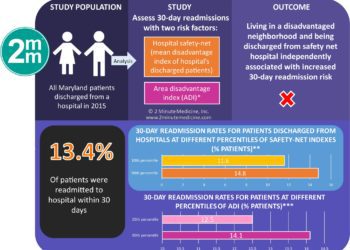Patient and care transitions factors play role in preventable hospital readmissions
1. In this multi-center and multi-perspective study about hospital readmissions, factors most strongly associated with preventable hospital readmissions included: emergency department decision to admit when an inpatient stay may not have been required, failure to communicate important information to outpatient health care professionals, discharging patients too soon after the initial admission, and lack of discussion about care goals in patients with serious illnesses.
2. While this study does highlight important factors associated with hospital readmissions, the underlying complex socio-economic factors that face many patients were not included.
Evidence Rating Level: 2 (Good)
Study Rundown: Reducing avoidable patient readmissions are an important issue in general internal medicine. Although there have been strategies to reduce readmissions, this still remains a major issue. Few studies have included the opinions of patients and health care professionals to determine readmission preventability. This study was conducted based on surveys from both patient and physician perspectives to determine the frequency of and factors associated with preventable hospital readmissions.
Approximately 27% of readmissions were considered potentially preventable, 52% of which were considered to be preventable if certain efforts were made during the index admission. The factors most strongly associated with potentially preventable readmission included: emergency department decision to admit when an inpatient stay may not have been required, failure to communicate important information to outpatient health care professionals, discharging patients too soon after the initial admission, and lack of discussion about care goals in patients with serious illnesses. Strengths of this study included a multicenter design and nationally representative cohort. Limitations included relative young age of participants, which decreases generalizability to the generally older patient population on general medicine wards.
Click to read the study, published today JAMA Internal Medicine
Relevant Reading: Effect of a postdischarge virtual ward on readmission or death for high-risk patients: an RCT
In-Depth [retrospective cohort]: This multi-center observational study included 1000 general internal medicine patients that were readmitted within 30 days of discharge in 12 US academic medical centers from April 2012 to March 2013. Clinical data was obtained from surveying patients, physicians and analysis of medical records. This data was reviewed in a 2-physician structured case-review to determine readmission preventability. The main outcome of interest was likelihood that a readmission could have been prevented. Multivariable regression was used to identify factors associated with potential preventability.
The cohort consisted of 1000 patients whose median age was 55 years old. Of readmitted patients, 26.9% were considered to be potentially avoidable, and of those, 52% were deemed preventable if certain efforts were taken during the index admission. Patients whose readmissions were deemed preventable reported similar experiences in terms of inpatient care processes and their ability to manage care after discharge as compared to those whose readmissions were deemed unpreventable. However, patients who did not know how to reach their physician after discharge were more likely to have their readmission considered preventable (18.6% vs. 12.6%; p = 0.02). In multivariable regression the 4 factors independently associated with potentially preventable readmissions included: premature discharge (adjusted OR (aOR) 3.88, 95%CI 2.44-6.17), failure to relay important information to outpatient health care professionals (aOR 4.19, 95%CI 2.17-8.09), lack of discussion about care goals among patients with serious illnesses (aOR 3.84, 95%CI 1.39-10.64), and emergency department decision making to admit patient who may not have required an inpatient stay (aOR 9.13, 95%CI 5.23-15.95). Other common factors associated with potentially preventable readmissions included inability to keep appointments after discharge and patients not knowing whom to contact after discharge.
Image: CC/Wiki
©2016 2 Minute Medicine, Inc. All rights reserved. No works may be reproduced without expressed written consent from 2 Minute Medicine, Inc. Inquire about licensing here. No article should be construed as medical advice and is not intended as such by the authors or by 2 Minute Medicine, Inc.







